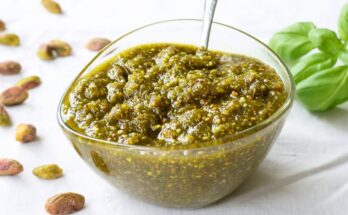Beef Jerky Recipe: Beef jerky is the ultimate high-protein snack that’s both delicious and convenient. Made by drying seasoned meat, this timeless treat has been a favorite for centuries.
Why make it at home? It’s simple—you get to control the flavors, ingredients, and quality, creating a healthier and tastier version than store-bought jerky.
This guide will walk you through each step, from choosing the right meat to storing your homemade creation.
Ingredients and Tools Needed
To make beef jerky, you’ll need:
Ingredients:
- 2 lbs of lean beef (top round, flank, or sirloin).
- ½ cup soy sauce.
- ¼ cup Worcestershire sauce.
- 2 tbsp brown sugar.
- 1 tsp garlic powder.
- 1 tsp onion powder.
- 1 tsp black pepper.
- 1 tsp smoked paprika (optional).
Tools:
- Sharp knife or meat slicer.
- Large mixing bowl.
- Airtight container or zip-lock bags for marinating.
- Oven, dehydrator, or drying racks.
- Baking sheets and aluminum foil (if using an oven).
Choosing the Right Cut of Meat
For the best jerky, always opt for lean cuts. Fat doesn’t dry well and can spoil the jerky. Here are some ideal options:
- Top Round: Affordable and lean with a firm texture.
- Sirloin Tip: Tender and easy to slice.
- Flank Steak: A bit pricier but packed with flavor.
Pro Tip: Look for meat with minimal marbling to ensure an even drying process.
Preparing the Meat
The foundation of good jerky lies in how you prepare the meat. Here’s what to do:
Trim the Fat: Remove as much visible fat as possible. Fat doesn’t dehydrate well and can lead to spoilage.
Slice Correctly:
- For tender jerky, slice the meat against the grain.
- For chewier jerky, slice with the grain.
- Aim for uniform slices about ⅛ to ¼ inch thick to ensure even drying.
Tip: Partially freeze the meat for 30 minutes before slicing. It makes cutting more manageable.
Creating the Marinade
A great marinade is key to flavorful beef jerky. Here’s a simple recipe to get started:
Basic Marinade Recipe:
- ½ cup soy sauce
- ¼ cup Worcestershire sauce
- 2 tbsp brown sugar
- 1 tsp garlic powder
- 1 tsp onion powder
- 1 tsp black pepper
Combine all ingredients in a bowl and whisk until the sugar dissolves. For extra zest, add chili flakes, liquid smoke, or your favorite spices.
Marinating the Meat
Marinating infuses the meat with flavor and tenderness. Follow these steps:
- Place the sliced meat into a large bowl or zip-lock bag.
- Pour the marinade over the meat, ensuring all pieces are fully coated.
- Seal and refrigerate for at least 4-24 hours. The longer, the better for deeper flavor penetration.
Tip: Occasionally shake or stir the container to evenly distribute the marinade.
Drying Methods for Beef Jerky
There are several ways to dry your jerky. Each method has its own charm:
Using a Dehydrator:
- Preheat the dehydrator to 160°F.
- Arrange meat slices on trays, ensuring no overlap.
- Dry for 4-6 hours, checking regularly.
Oven Drying:
- Set the oven to the lowest possible temperature (150-170°F).
- Lay meat on wire racks over lined baking sheets.
- Leave the oven door slightly ajar to allow moisture to escape.
Sun Drying (Traditional Method):
- Hang meat strips in a sunny, dry area with good airflow.
- Protect from insects with a mesh covering.
Tip: Always ensure jerky reaches an internal temperature of 160°F for food safety.
Monitoring the Drying Process
To achieve perfectly dried beef jerky, constant monitoring is crucial. Here’s how you can ensure success:
- Visual Check: The jerky should appear dry and slightly darkened, with no moisture on the surface.
- Texture Test: Take a piece and bend it gently. If it cracks but doesn’t break completely, it’s done. If it feels sticky or spongy, it needs more time.
- Rotate Trays: If you’re using a dehydrator or oven, rotate the trays periodically to ensure even drying.
Drying times can vary depending on the thickness of the slices and the method used. On average:
- Dehydrator: 4-6 hours.
- Oven: 3-5 hours.
- Sun drying: 2-3 days (depending on weather conditions).
Tip: Over-drying will make the jerky brittle, so keep a close watch during the final stages.
Storing Your Beef Jerky
Once your jerky is ready, proper storage is essential to maintain its quality and prevent spoilage:
Cool Completely: Allow the jerky to cool to room temperature before storing. Warm jerky can trap moisture, leading to mold.
Choose the Right Containers: Store in airtight containers, vacuum-sealed bags, or zip-lock bags.
Refrigeration:
- Room temperature storage is fine for up to 2 weeks in a cool, dry area.
- For longer storage (up to 3 months), keep the jerky in the refrigerator.
- Freeze for up to 6 months if needed.
Tip: Add a food-safe silica gel packet to the storage container to absorb any residual moisture.
Common Mistakes to Avoid
Even seasoned jerky makers can encounter hiccups. Avoid these common mistakes:
- Skipping the Fat Trim: Leaving too much fat leads to faster spoilage.
- Uneven Slicing: Irregular slices dry unevenly, leaving some pieces overdone and others underdone.
- Overcrowding Trays: This blocks airflow, resulting in inconsistent drying.
- Rushing the Process: Proper marination and slow drying are crucial for flavor and texture.
Tip: Patience pays off—don’t cut corners, and you’ll be rewarded with top-notch jerky.
Flavor Variations for Beef Jerky
Once you’ve mastered the basics, get creative with your jerky flavors! Here are some popular variations:
Spicy Kick: Add chili powder, cayenne pepper, or hot sauce to the marinade.
Sweet and Savory: Mix in honey, maple syrup, or pineapple juice for a sweet twist.
Teriyaki Style: Use soy sauce, brown sugar, ginger, and sesame oil for a classic teriyaki flavor.
Global Flavors:
- Mexican: Lime juice, cumin, and smoked paprika.
- Korean: Gochujang (Korean chili paste) and sesame seeds.
- Indian: Garam masala, turmeric, and coriander.
Experiment with herbs, spices, and liquids to create your own signature jerky!
Health Benefits of Homemade Beef Jerky
Making your own beef jerky offers several health benefits:
- High Protein Content: A perfect snack for fitness enthusiasts.
- Low in Fat: By trimming fat, you control the calorie content.
- No Additives or Preservatives: Unlike store-bought versions, homemade jerky doesn’t contain artificial chemicals.
- Customizable Nutrition: Adjust sodium, sugar, and spice levels to suit your dietary needs.
Tip: Homemade beef jerky is a guilt-free snack, packed with energy for hikes, workouts, or busy days.
Serving Suggestions
Wondering how to enjoy your beef jerky beyond snacking? Here are some ideas:
- As a Snack: Pair with nuts, dried fruits, or cheese for a protein-packed trail mix.
- In Soups and Stews: Chop and add jerky to soups for a savory protein boost.
- Salad Topping: Crumble over salads for texture and flavor.
- Party Platters: Include jerky in charcuterie boards alongside crackers and dips.
Tip: Jerky pairs wonderfully with a cold beer or a hearty glass of red wine.
FAQs about Beef Jerky Recipe
1. What cuts of meat are best for making beef jerky?
The best cuts for beef jerky are lean with minimal fat, such as top round, bottom round, or sirloin tip. These cuts ensure your jerky is chewy but not tough.
2. How should I prepare the meat for jerky?
Begin by trimming all visible fat, as fat does not dry out and can cause the jerky to spoil faster. Slice the meat into consistent, thin strips about 1/8 to 1/4 inch thick. For easier slicing, partially freeze the meat beforehand.
3. What are the basic ingredients for a jerky marinade?
A basic jerky marinade includes soy sauce, Worcestershire sauce, black pepper, and garlic powder. You can customize it by adding brown sugar for sweetness, red pepper flakes for heat, or liquid smoke for a smoky flavor.
4. How long should I marinate the beef for jerky?
Marinate the beef strips for at least 4 hours, though overnight marination is recommended for deeper flavor penetration. Ensure the meat is fully submerged in the marinade for even seasoning.
5. What drying methods can I use to make beef jerky?
You can dry beef jerky using a dehydrator, an oven, or even an air fryer set to a low temperature. Ensure that the air can circulate around the meat strips for even drying.
6. How do I know when beef jerky is done drying?
Beef jerky is done when the meat is dry yet pliable. It should bend without breaking and not feel moist. In a dehydrator, this typically takes about 4 to 6 hours, but oven drying can take up to 8 hours depending on thickness.
7. How should I store homemade beef jerky?
Store beef jerky in an airtight container to keep it fresh. If kept in a cool, dry place, homemade jerky can last up to 1-2 months. For longer storage, you can refrigerate or freeze it.
8. Is homemade beef jerky a healthy snack?
Yes, beef jerky can be a healthy snack if made with lean cuts of meat and low-sodium marinades. It’s high in protein and when homemade, it’s free from the preservatives found in commercially-produced jerky.
Conclusion
Making beef jerky at home is a rewarding process that lets you enjoy a nutritious, flavorful snack tailored to your tastes. From choosing quality meat to experimenting with marinades, every step adds a personal touch. Whether you’re packing it for a hike or enjoying it at home, homemade beef jerky is always a hit. So grab your ingredients and start crafting the perfect batch today!



